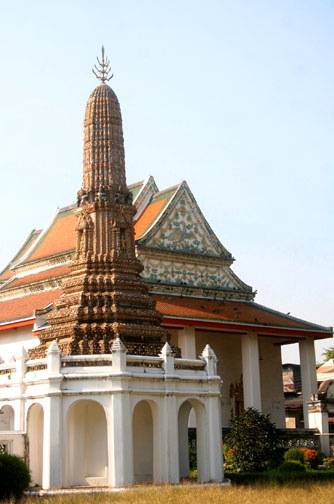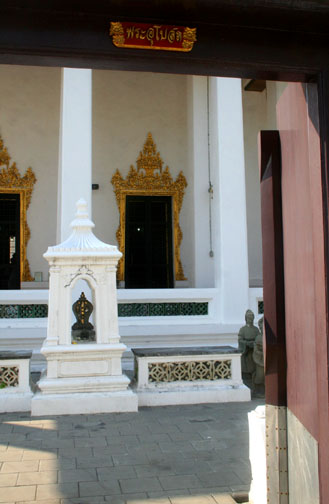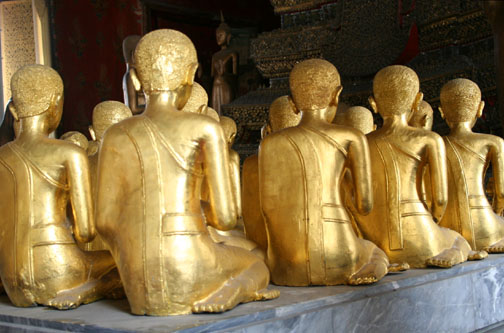
Wat Thepthidaram has a distinctive Chinese air and it is heavily decorated with pieces of Chinese porcelain.
I’ve seen a lot of Buddhist nuns in Cambodia. In Thailand, not so much. Or at least what I’ve always referred to as nuns. Perhaps due to being sexist, or more familiar with traditional western religious practices, I never considered that they might be monks. Turns out there are in fact female Buddhist monks. Just not very many. And it turns out Buddhism is sexist too; the practice of ordaining women into the monkhood is controversial. Except in Thailand. Where it’s not allowed.
You can, however, find female Buddhist monks, or Phikshuni, at Wat Thepthidaram Worawihan in Bangkok, a large and somewhat decrepit temple tucked behind Wat Ratchanadda, about 300 meters further down Mahachai Road. The wat, a Third grade royal temple formerly known as Wat Ban Phrayakrai Suanluang, was built by King Rama III in 1836. It houses 52 Phikshuni. But they are about the size of a hobbit and are made of gold leaf covered brass. Meditating, sitting, talking, listening, smoking, and chewing gum, they gather in front of the Buddha inside the wat’s wiharn, and serve to honor the Buddhist Phikshuni order.
Phikshuni, in Thailand, Bhikshuni in the rest of the Buddhist world, originated by decree of the Buddha. Though that may have been more acquiescence than decree. Pranangmahapachabodhicotamee, the woman who took care of the Buddha when he was young, asked him to allow women to be ordained. She asked three times. He declined to open that bail of hay each time she asked. As wise as the Buddha was, he wasn’t smart enough to know women do not take no for an answer.
Shaving her head and gathering 500 of her hen posse with her, she approached the Buddha and asked again. He still said no. Then she tried tears. Usually a good ploy, that didn’t work either. Then, using her feminine wiles, she convinced Phra Anont, a male monk, to take up her cause. Phra Anont asked the Buddha if a woman were ordained could she then reach enlightenment. The Buddha said she could. So Phra Anont used the Buddha’s words against him and persuaded the Buddha to allow the ordination of women into the monkhood.
From that original 500 female Buddhist monk allowed to be ordained by the Buddha, their numbers became legion as they spread throughout India. Their movement travelled into Sri Lanka where the Phikshuni existed for about 1,000 years before finally disappearing for some unknown reason.
Though the practice of ordaining women into the monkhood never spread to Thailand, King Rama III honored their memory by having the 52 statues that are housed at Wat Thepthidaram built. Conflicting records say that the wat was built in honor of a woman who had worked for the King for a long time, or in honor of and dedicated to his daughter, Princess Kroma Muen Apsomsudathep.
Approaching the temple from Wat Ratchanadda, it appears abandoned. There is a large weed choked lot between the wat’s inner and outer walls, and it’s ubosot, the first building you come upon, is closed and looks to not be in use. Its roof gable is decorated with Chinese Porcelain and has none of the traditional finials you normally find on wats in Thailand. The temple has a distinct Chinese flair to it and numerous old Chinese statues can be found around the temple’s grounds. Around its small courtyard there are four large red wooden doors, barred and padlocked shut each leading to a space no bigger than a closet. Not sure what that’s all about, but I like old wooden red doors.
The temple’s wiharn sits in its own courtyard beyond a set of low wrought iron gates and is in much better shape. There are several old wooden monk residences both at the front and backside of the wiharn, one of which was the home of Sunthorn Phu, a famous Thai poet who is considered the Shakespeare of Thai literature. He was ordained as a monk at Wat Thepthidaram and spent three years of his tumultuous life at the temple after he fell out of favor with King Rama III.
As uninviting as the wat’s grounds are, on all three visits I’ve made to Bangkok’s angel’s wat, there has been a small group of local men at the wiharn who greet visitors warmly and beckon you inside. The faded red interior of the wat, with gold leaf decorations adorning its walls, is a dramatic background for the mass of gold Buddhist imagery that forms the altar area and takes up almost half of the room’s space.
At first glance, you might not realize the significance or meaning behind the mass of monk statues kneeling in reverent positions before the Buddha, or even that they depict female monks. But a three panel storyboard at the back of the front entrance explains their story. What it does not explain is the current status of women monks in Thailand. Of which there is only one. And she was ordained in Sri Lanka and is not recognized by the Buddhist church in Thailand.
Dhammananda, Thailand’s only Theravada Buddhist female monk, was fully ordained in Sri Lanka as a valid Theravada Phikshuni along with seven other women when the order was reestablished in that country in 1998. The Thai Sangha does not recognize her, nor the Bhikshuni of Taiwan, citing differences in philosophical teachings and monastic discipline. The idea of female monks in Thailand is a controversial one, with 90% of Thais opposed to woman monks. Women attempting to ordain have been accused of attempting to impersonate monks (a civil offense in Thailand), and their actions have been denounced by many members of the ecclesiastic hierarchy.
“When I was first ordained, there were people that wanted to be ordained also, but they didn’t dare, so they waited to see if I got clobbered first,” says Dhammananda.
The dispute over women in the monkhood has fallen on deaf ears. And a female senator who called for the ban on women to be scrapped received death threats. While Buddhist patriarchs concede that the Buddha himself ordained women, they point to monastic rules that require that both five ordained monks and five ordained phikshuni be present for any new phikshuni ordination. Without such a quorum, they say that it is not possible to ordain any new women monks. And since there are no phikshuni in Thaialnd, that quorum can never be reached.
For the time being, woman who want to devote their life to Buddha in Thailand have to settle for being a nun, though that is still a lay position. Under the patronage of Her Majesty the Queen, the Institute of Mae Ji is composed of non-ordained religious specialists who shave their heads and wear white robes, vowing to practice Buddhist precepts which include a vow of chastity, refraining from taking food after noon to dawn, refraining from dancing, singing, listening to or playing music or watching plays, refraining from using garlands, scent, unguents, wearing finery, and using high or large beds. They are expected to live a monastic life, making merit in the hopes of being born in a different role in their next life. Uh, that’d be as a man.
Mae Ji do not generally receive the level of support given to ordained monks, nor do they have rights or status. But they are honored as higher than general lay men due to their formal uniforms, vows, and religious practices. Buddhist nuns primarily participate in religious life as participants in collective merit-making rituals, or by doing domestic work around temples. Nut Thailands roughly 30,000 Buddhist nuns wind up spending more time doing menial chores than meditating, says social worker Ouyporn Khuankaewm, who works with monks and nuns. “So many are controlled and oppressed by the monks,” she says. “The monks say, ‘Your job is to clean and cook and if you don’t do that, you don’t get to eat or stay at the temple.’”
So the only female monks you will see in Thailand are at Bangkok’s Wat Thepthidaram. Though they are only statues, they seem to exemplify the characteristics the Thai Buddhist male dominated religious hierarchy expects out of its female members; shut up, kneel, stay quiet, and keep out of the way of those who have a true purpose in life: men.








Great post, both entertaining and informative!
Thanks JLP!